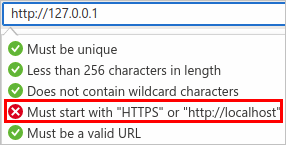We recommend using the broker for logging in with AAD.
https://learn.microsoft.com/en-us/entra/msal/java/advanced/using-wam-and-the-msal4jbrokers-package
Open fethullahmisir opened 5 months ago
We recommend using the broker for logging in with AAD.
https://learn.microsoft.com/en-us/entra/msal/java/advanced/using-wam-and-the-msal4jbrokers-package
Relevant Documentation: According to Microsoft Documentation, 127.0.0.1 should be preferred over localhost.
Interesting. At one point, that recommended 127.0.0.1 was unable to be set via Azure Portal; such a limitation was also - and is still - mentioned in that doc:
 For that historical reason,
For that historical reason, localhost is widely used in many apps and even hardcoded in some MSAL implementations.
It seems that the portal accepts 127.0.0.1 now. Therefore, this bug report is fair.
P.S.: Perhaps localhost is still the only way to support IPv6, for now.
The Documentation uses the Screenshot from Single Page Application Section of the Portal.
In the "Mobile and desktop applications" section, its possible to add http://127.0.0.1 without needing to use the Manifest workaround.
In the "Mobile and desktop applications" section, its possible to add http://127.0.0.1 without needing to use the Manifest workaround.
It is possible now. It wasn't possible before. I don't know when it changed, but I am sure it wasn't possible even for "mobile and desktop app". Just a FYI.
Library version used
1.15.0
Java version
8
Scenario
PublicClient (AcquireTokenInteractive, AcquireTokenByUsernamePassword)
Is this a new or an existing app?
This is a new app or experiment
Issue description and reproduction steps
Using http://127.0.0.1 as the redirect URI does not work because it is overridden with http://localhost. This override causes the login to fail as http://localhost is not defined in the App Registration. According to Microsoft documentation, 127.0.0.1 should be preferred over localhost.
Workaround: Using an address with a fixed port like http://127.0.0.1:3490 works because the redirect URI is not overridden. However, this workaround is not ideal as it introduces the risk of port conflicts.
Relevant Documentation: According to Microsoft Documentation, 127.0.0.1 should be preferred over localhost.
Relevant code snippets
Expected behavior
The redirect URI should remain as http://127.0.0.1 .
Identity provider
Microsoft Entra ID (Work and School accounts and Personal Microsoft accounts)
Regression
No response
Solution and workarounds
The relevant place in code is:
https://github.com/AzureAD/microsoft-authentication-library-for-java/blob/dev/msal4j-sdk/src/main/java/com/microsoft/aad/msal4j/AcquireTokenByInteractiveFlowSupplier.java#L103
The URI is hard coded and should be loaded from the interactiveRequestParameters() instead.